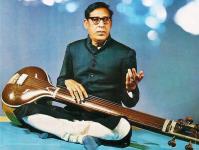 Ustad Amir Khan (1912-1974) Ustad Amir Khan (1912-1974)Ustad Amir Khan Sahab was one of the foremost indian vocal artist of India. He was the founder of Indore Gharana.
Ustad ji was born on 15th August 1912 in Indore, in a musical family. His father Shamir Khan saheb was a musician. He was used to play Sarangi and Veena. His grandfather was a court musician of Bahadur Shah Zaffar. Over a period of five or six years, and in stages, young Ameer Ali internalized the Merukhand system under the guidance of Ustad Nasiruddin Dagar. Thereafter, he was taught Khayal singing, along with occasional lessons on the sarangi. Alongside his training within the family, young Ameer Ali was exposed to some of the finest musicians of Indore every week-end, when his father’s friends gathered to perform for each other. Amongst the giants he heard and studied at these sessions were the dhrupad vocalists, Allahbande Khan, Nasiruddin Khan Dagar, Beenkar Murad Khan, Beenkar Wahid Khan, sarangi exponent, Bundu Khan, and the khayal vocalist, Rajab Ali Khan of Dewas.
Ustad Amir Khan performed in several cities of the country. His slow alaap and tones would test the listeners’ patience at one point, but as the listener went deep into his music, its magic would overpower. When he sang, he appeared totally lost and engrossed in his own singing. Ustad Amir Khan create Indore Gharana by following and studied the style of Ustad Abdul Wahid Khan, Aman Ali Khan, Rajab Ali Khan and Abdul Karim Khan and amalgamated their style. This unique style, known as the Indore Gharana, blends the spiritual flavour and grandeur of dhrupad with the ornate vividness of kheyal. Besides singing in concerts, Amir Khan also sang film songs in ragas, in a purely classical style, most notably for the films Baiju Bawra, Shabaab and Jhanak Jhanak Payal Baaje. Ustad Amir Khan Saheb had a great contribution in the field of Tarana. He researched and studied the words of Tarana which came from Persian and Arabic languages and composed several taranas. He was also a great Ustad. His well known disciples are Amarnath, A. Kanan, Ajit Singh Paintal, Akhtar Sadmani, Amarjeet Kaur, Bhimsen Sharma, Gajendra Bakshi, Hridaynath Mangeshkar, Kamal Bose, Kankana Banerjee, Mukund Goswami, Munir Khan, Pradyumna Kumud Mukherjee and Poorabi Mukherjee ,Sunil Majumdar , Pandit Tejpal Singh and Surinder Singh.
Ustad Amir khan saheb was awarded Padma Bhushan in 1971. Besides that Sangeet Natak Academy Award in 1967. Khansahib died in a car accident in Calcutta on 13 February 1974 aged 61, and was buried at Calcutta's Gobra cemetery. The legacy of Ustad Amir Khan Sahab is carried by his students.
|


